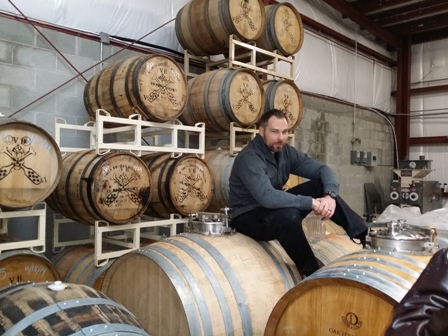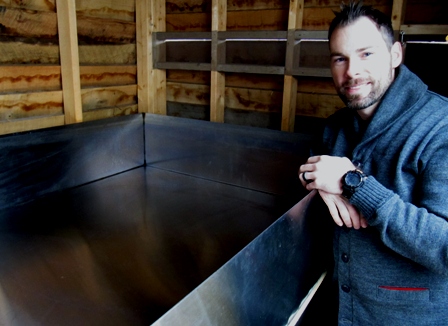By Elizabeth Erschens & Diane Catanzaro
Pucker up people. Sour power will transform your mind as it tantalizes your tongue, as Beach Brewing enters the third dimension of brewing. While most people think of beers as one-dimensional (that dimension being bitter), and stout lovers recognize the second dimension (roasted flavors), Beach Brewing is exploring where no Southside Hampton Roads brewery has gone before, diving headfirst into the third dimension of beer flavor and that is sour. Yes, in our very own Virginia Beach spring break edition of “Beers Gone Wild,” Beach Brewing will be debuting several “sours” in 2015 with more to come in 2016 and beyond.
Justin MacDonald, Beach Brewing Company’s founder, owner, and brewmaster said “We plan to release about five sours in addition to some of the other barrel-aged stuff we have coming up.” What is extra special is they plan to produce some of their sour beers spontaneously with 100 percent local micro-flora instead of pitching a prepackaged culture.
Sour beers have been a huge trend in craft beer American in recent years, yet they are anything but new. In fact, most beers were originally sour beers, fermented with wild yeast. Nobody really knew exactly what it was that made beer ferment, so was assumed to be either an act of God, magical luck, or trial and error success based on using certain wooden barrels, a special wooden mash rake, or some of the previous batch as a ‘starter’ they had success in brewing beer. What the brewers didn’t know was that the “magic” was wild yeast embedded in the wooden equipment or brewery microflora environment, and that is why the barley porridge the brewers of yore cooked up later turned into alcohol. Yeast had not yet been discovered and isolated.
Once Louis Pasteur and Emil Hansen identified, tamed and cultivated the lager yeast cell, saccharomyces carlsbergensis, in the 1880s, beer no longer turned sour. Almost everyone was excited about this! The nice folks at Carlsburg shared their yeast freely and just about every brewer in the world started using this clean-fermenting lager yeast to make beers that were predictable and entirely un-sour. The major exception to this was a small number of Belgian brewers in the Senne Valley region near Brussels who kept creating traditional sour lambics and gueuzes using yeast that spontaneously landed in the cooling wort to start munching the sugars and creating alcohol. Only a handful of small family brewers and blenders in Belgium have clung to the tradition of brewing and blending these spontaneously fermented sour beers. However, as craft brewers in America and elsewhere “discovered” these beers in the past decade or so they begun to brew a wide range of sours. At a decent craft beer bar today you may see an entire sour section of the menu with beers from all over the world. And, like a wave that finally reaches our distant shore, this trend has finally come ashore in Hampton Roads. It’s about time!
Here’s the thing: Today, these wild yeasts and microbes have been cultivated and packaged and you can buy them and pitch them into your wort to create a sour beer. These microbes have names like lactobacillis, pediococcus, and brettanomyces. However, Beach Brewing is going to do several of their sour beers with 100% spontaneous fermentation from wild yeast and microbes in their very own backyard. Kind of like the difference between farm-raised salmon and going out and catching your own salmon in your backyard. Of course, there are no salmon in Beach Brewing Company’s backyard, but there is still a bit of Virginia Beach nature off Horse Pasture Road, with wild yeasts and microbes floating around the green landscape, and Justin MacDonald is going to entice them with a siren song to come for a late-night swim in his coolship. His WHAT?
MacDonald installed a 200 gallon “coolship” (the Dutch/Flemish word is koelschip) behind the brewery. This is a flat, open vessel, sort of like a shallow child’s swimming pool, with a large surface area that allows for quick cooling and an enticing environment for yeast and microflora to stop by to grab some sustenance. To make a sour beer you boil your malted and/or unmalted grains, add some aged hops (you don’t want hops flavor or bitterness in your sour beer), then pump this concoction, called wort, into the coolship to cool overnight. While the brew is cooling you pray that the fairy yeast-mother and her microbial disciples take a late night dip in the pool, gorge themselves on the barley sugars, and have flagrant delecto as if they were teenagers in a private hot tub at an Oceanfront hotel on prom night. A telltale foam will rise on the surface of the brew indicting the yeast have had a happy evening. The next day you transfer the concoction into either a stainless steel fermentor or one of the veritable flotilla of oak barrels MacDonald has been collecting; forty-year-old sherry casks from Portugal, French wine barrels, 500 liter puncheons, Bowman Distillery bourbon barrels, former cognac barrels. The beer will age in these barrels for a minimum of one year, but some will age even longer. Then different age batches may be blended, similar to wine, to create a balance of flavors.
Hey, the barrels sound cool. But back up a minute. Did he say he plans to purposely infect his beer with wild yeast and bacteria. How is he going to keep that mess from souring his normal beers? “That’s the first question most people ask” according to MacDonald. Don’t worry, MacDonald will practice safe suds. His coolship is housed in an outdoor white oak shed with screens that will keep out larger life-forms. All of this wild late night skinny dipping takes place OUTSIDE the brewery, in the “cool shack” that houses the coolship. You definitely must prevent any cross-contamination of wild yeasts with the brewing equipment you are using to brew your beers that are not sour. The Ghost Ship Pale Ale, the Hoptopus Double IPA, the Kraken Tripel IPA, the Hurricane American Wheat, and so forth must be protected, they should never, ever meet Lola Lactobacillis, Pete Pediococcus, or Brett Anomyces.
What other steps does MacDonald take to prevent an accidental infection of his regular beers? He explains, “We keep a clean side in the brewery, in that all equipment used for sour beer, even the pumps, hoses, and bright tank are never used for the non-sour beers.” McDonald continued, “We are all covered in wild yeast and bacteria ourselves, so it really isn’t any different than the sanitation measures you always used when brewing beer.” MacDonald also plans to use separate kegs once the beer has been in the coolship for about 12 to 16 hours, or when the boiling wort pumped into the cool ship reaches 70 degrees. The process is all controlled by the outside temperature. He said he would be brewing the last coolship batch until spring in early January, as the temperatures will be so low that there won’t be as much natural micro-flora visiting the Beach. He could always hope for some hardy Canadian yeasts to visit in the dead of winter and jump into the coolship wearing their little microbial Speedos.
Now just how long are we going to have to wait to try this sour beer? McDonald said, “I can’t answer that. Most likely about a year and a half, or until it is finished and matured. I won’t even bother evaluating it for at least a year to allow the yeast and bacteria to interact with the small amount of oxygen allowed in by the barrels.” To keep the oxidation level lower, he will use larger barrels (called “puncheons”) so there won’t be as much surface area per liter of beer.
When we learned that after a year or so the beer in the various barrels will be evaluated and blended, both of us quickly raised our hands to volunteer as tasters. After all, it is the least we can do for the first brewer trying his hand at sour beer on the Southside of Hampton Roads.
It you were starting to fret about having to wait a year and a half for Beach Brewing’s sour beers, you can relax. Along with his other barrel-aged beers, McDonald is producing other sour beers with pitched culture combinations—or “cocktail,” as he calls it—of specific cultures along with a little of the beer from the cool ship. This way, all of his sours will contain unique brewery character created by natural local micro-flora.
The first release of a Beach Brewing sour was slated on January 16, 2015. It is a Raspberry Berliner Weisse, called “A1 Chemical REM.” McDonald describes it as “ale refermented in oak barrels with raspberries,” and it will weigh in at 5.8% ABV. This will be a limited release of only two half barrels, so with the exception of a few bottles going to Lynnhaven Pub and Grape & Gourmet, you will have to stop by Beach Brewing’s tasting room to enjoy it. We can’t wait to savor the sour!





